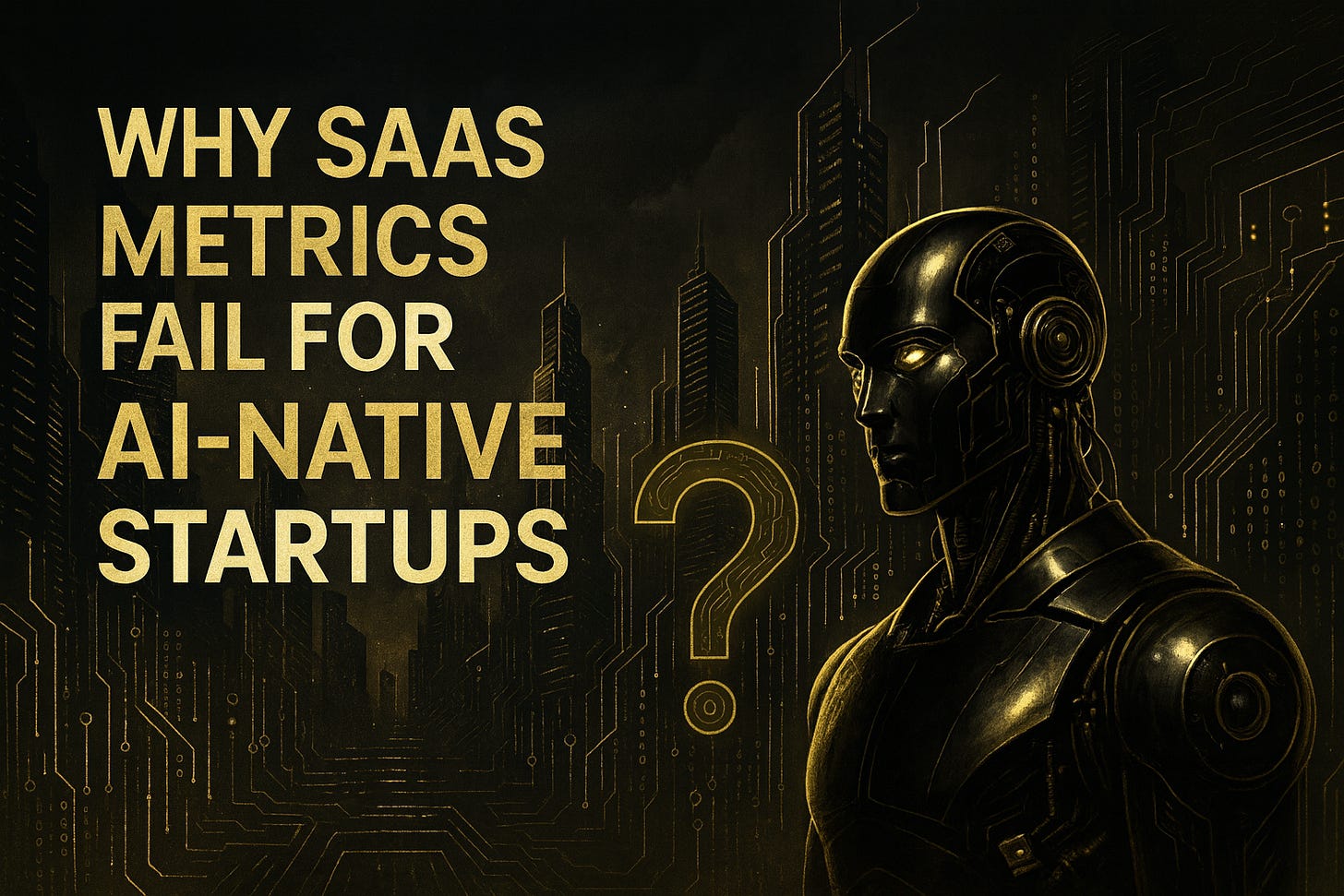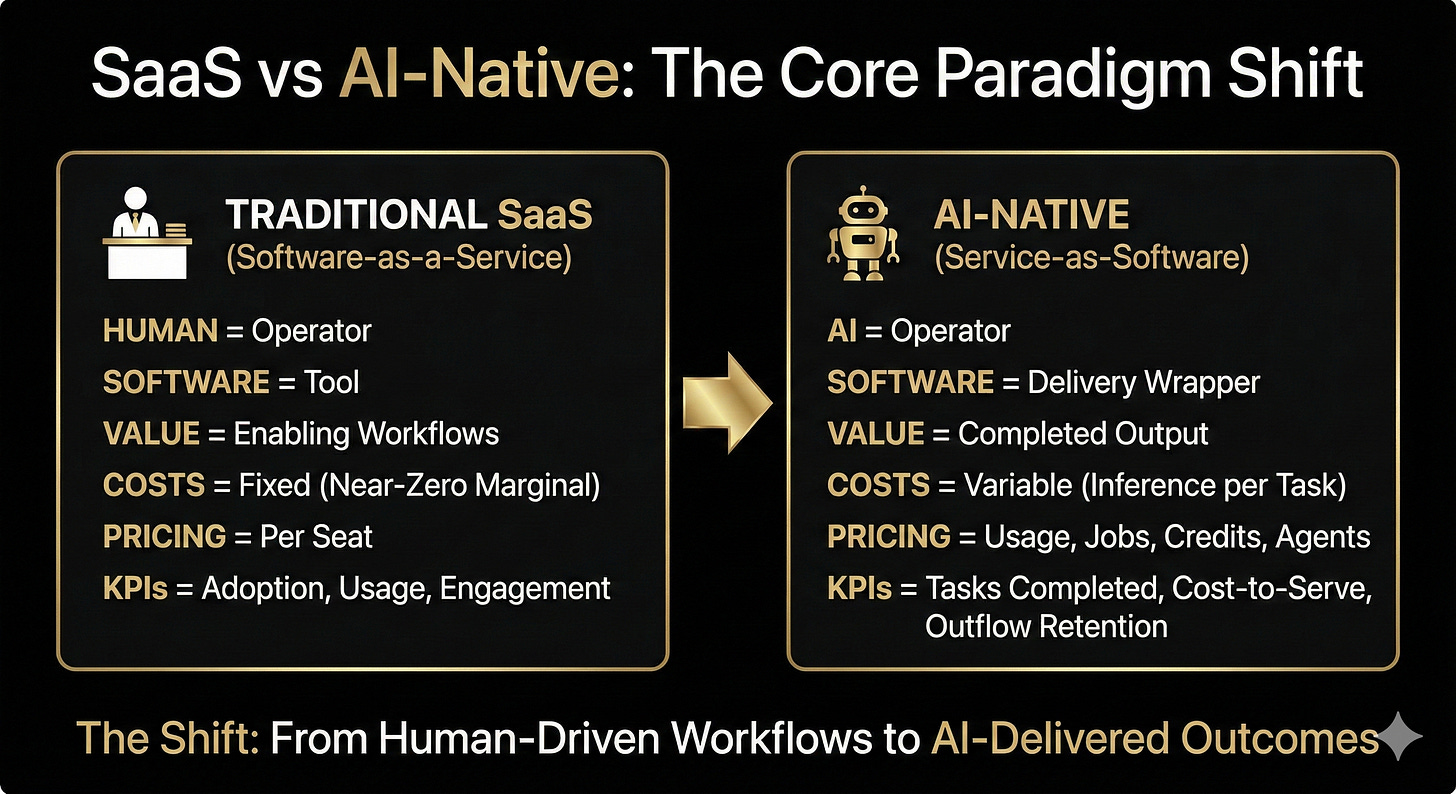⚙️ Why SaaS Metrics Fail for AI-Native Startups
🔧 It is like Using a Dipstick to Service a Tesla
🔥 In this piece:
🤖 What AI-Native Really Means
🧩 SaaS vs SaS: The New Foundation
📉 Why the Old SaaS Scoreboard Fails
📊 The New AI-Native Scorecard
🎯 Why This Matters for Founders & Investors
If you measure AI-native platforms with old SaaS KPIs, you’ll back the wrong founders and misprice the winners.
For anyone building or investing in the AI wave, one thing is now clear: if you evaluate AI-native companies using traditional SaaS metrics, you will misdiagnose the business, misunderstand the economics, and allocate capital in all the wrong places.
For twenty years, SaaS operated on a stable foundation. Software helped humans complete workflows. Pricing was per seat. Growth was linear. And the metrics were predictable: ARR, the Rule of 40, LTV:CAC, net retention, and those comforting 80–90% gross margins.
That model was correct for its era. It is not correct for this one.
A new class of company has emerged — Cursor, Lovable, Manus and others — and they do not behave like SaaS. They do not scale like SaaS. They do not retain users like SaaS. Their cost structure is nothing like SaaS.
These companies are AI-native.
Not “SaaS with an AI feature.”
Not “a wrapper on GPT-4.”
Not “we fine-tuned a model.”
AI-native is an entirely different product architecture — and therefore an entirely different economic system.
Yet the industry is still scoring them on the wrong scoreboard.
🤖 What AI-Native Really Means (Not What People Think)
Most people assume “AI-native” means building your own model, training your own LLM, or deploying proprietary architectures.
This is a misunderstanding.
AI-native = the AI does the work, not the human.
More precisely:
The AI is the operator.
The product delivers finished outputs, not workflow steps.
The unit of value is the completed job, not time spent in product.
Every unit of value carries a real inference cost.
The product cannot exist without the AI performing the work.
This has nothing to do with whether you use Claude, GPT-4, Llama, Mistral, or a hybrid router.
AI-native = outcome-producing, cost-bearing, value-generating systems.
Once you define it this way, the economics become obvious.
LISTEN TO THE DEEPDIVE PODCAST
Why SaaS Metrics Are Failing the Next Generation of Startups
This deep-dive episode breaks down why traditional SaaS metrics—ARR, NRR, LTV:CAC, per-seat pricing, and 80–90% margins—are dangerously misleading when applied to AI-native companies.
🧩 SaaS vs SaS: The New Foundation
Fusion42 and Investor-X use a distinction that is becoming foundational across the ecosystem:
SaaS — Software-as-a-Service
Human = operator
Software = tool
Value = enabling workflows
Costs = fixed, near-zero marginal cost
Pricing = per seat
KPIs = adoption, usage, engagement
SaS — Service-as-Software
AI = operator
Software = delivery wrapper
Value = completed output
Costs = variable (inference per task)
Pricing = usage, jobs, credits, agents
KPIs = tasks completed, cost-to-serve, outflow retention
Most modern AI-native products are SaaS shells with SaS cores — a familiar interface wrapped around an autonomous service engine.
And once you see this, the conclusion is unavoidable:
SaaS metrics measure human behaviour.
SaS metrics measure output economics.
Judging SaS platforms with SaaS metrics is like diagnosing an electric drivetrain with petrol-engine tools.
You’ll get confident answers — and all of them wrong.
📉 Why the SaaS Scoreboard Fails (Metric by Metric)
1. Gross Margin: Not a Percentage — a Trajectory
Typical SaaS: 80–90%
Early AI-native: 40–60%
Not because AI-native is weak, but because:
SaaS COGS is flat
AI-native COGS scales with outputs
every action incurs compute cost
users vary massively in cost-to-serve
The correct KPI is Gross Margin Trajectory — not the static percentage.
2. CAC: High CAC + High COGS = Dead Company
When marginal costs are real, the only viable GTM is:
product-led
viral
instant value
self-serve
The correct KPI is CAC trendline vs inference efficiency, not CAC payback.
3. Retention: The Real Curve Starts at Month 3
AI-native products attract “AI tourists.”
Month-1 retention is noise.
The real signal is:
M3 → M12 Cohort Retention
Healthy curves show:
tourists out
professionals in
usage up
spend up
cohorts that dip → flatten → rise (“the smile”)
Traditional NRR hides this.
4. Engagement Metrics Are Obsolete
SaaS measures:
DAU/MAU
time in product
workflow usage
AI-native must measure:
jobs completed
workflows executed
assets produced
tasks automated
Engagement is not value. Output is value.
5. Pricing: Seats Are Dead. Outcomes Win.
SaaS pricing is cost-agnostic.
AI-native pricing must be cost-aligned:
usage
credits
outcomes
tasks
per-agent (“AI employee”)
Outcome-based pricing aligns value, cost, and margin.
📊 The New Scoreboard: The Investor-X Scorecard
-
1. Inference Cost per Active Customer (ICAC)
Your new North Star.
Falling ICAC = compounding business.
2. Jobs Owned per Account
The real measure of dependency, value, and moat.
3. M3 → M12 Retention
By Month 3, only real users remain.
Healthy: 85–120% M12/M3.
4. Gross Margin Trajectory
Direction matters more than destination.
5. Wallet Share of Customer AI Spend
Seat count is irrelevant.
Workload share is everything.
🎯 Why This Matters
If you judge AI-native companies with SaaS metrics, you will:
underestimate growth
misread retention
misunderstand cost curves
misprice valuations
and back the wrong founders
This shift is as large as:
internet → cloud
cloud → mobile
mobile → AI-native
AI-native companies are not “SaaS with AI features.”
They are autonomous service engines delivered through SaaS interfaces.
Once the unit of value shifts from workflow → output, every metric must shift with it:
economics
pricing
retention
moats
valuation
strategy
This is why the SaaS scoreboard fails.
And it’s why those who adopt the AI-native scoreboard now will win the next decade.
Thank you for reading. If you liked it, share it with your friends, colleagues and everyone interested in the startup Investor ecosystem.
If you've got suggestions, an article, research, your tech stack, or a job listing you want featured, just let me know! I'm keen to include it in the upcoming edition.
Please let me know what you think of it, love a feedback loop 🙏🏼
🛑 Get a different job.
Subscribe below and follow me on LinkedIn or Twitter to never miss an update.
For the ❤️ of startups
✌🏼 & 💙
Derek







